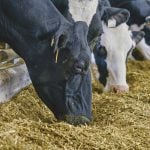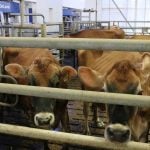Chicago Mercantile Exchange live cattle futures closed higher on Thursday on short-covering in an otherwise quiet post-holiday session, traders said.
December live cattle futures finished 0.35 cent higher at 132.7 cents per pound, and February gained 0.425 cent at 134.15 cents (all figures US$).
Investors await this week’s cash cattle sales, knowing packer margins are poor and beef demand has been inconsistent.
The sluggish beef demand, which is not expected to improve until the new year, has created a negative tone in the cattle market, said K+S Financials analyst Jack Salzsieder.
Read Also

U.S. livestock: Cattle futures sink on concerns over Trump’s push to lower prices
Chicago | Reuters – U.S. cattle futures tumbled on Monday, extending a steep slide after President Donald Trump complained last…
Cash cattle bids in Texas and Kansas were at $129 per hundredweight (cwt), with no response from sellers, feedlot sources said. Last week, the bulk of cattle in the U.S. Plains moved at $130, they said.
Thursday morning’s wholesale price for choice beef was up 42 cents/cwt from Tuesday at $197.28, while the select cutout dropped $1.10 to $190.88, USDA said.
Beef packer margins for Thursday were estimated at a negative $72.55 per head, compared with a negative $51 per head a week ago, according to HedgersEdge.com.
Packers have little interest in raising bids for cash cattle with some plants operating at reduced levels during the Christmas and New Year’s holidays.
Cargill’s beef packing plant in Dodge City, Kan., which was idled by fire on Monday, is expected to return to normal operations as early as Saturday, a company spokesman said in an e-mail.
Live cattle futures received an added boost from buying in CME’s feeder cattle market.
Feeder cattle at the CME moved higher as corn prices declined on worries that demand from China may ease. Lower-cost corn could encourage feedyards to buy young cattle.
Feeder cattle for January closed at 166.6 cents/lb., up 0.35 cent, and March finished at 167.2 cents, up 0.55 cent.
Hogs sag on pork demand
CME hogs, on a continuous lead-month chart basis, landed in negative territory for a fourth straight session, pressured by lower wholesale pork prices, traders and analysts said.
The morning’s U.S Department of Agriculture wholesale pork price was down $1.75/cwt from Tuesday to $84.14, brought down by $4.89 drop in pork bellies, which are made into bacon, USDA said.
“There’s a lot of bellies in storage right now. And, bacon demand could stumble as people return from holiday vacations,” a trader said.
Traders sold February hog futures and bought deferred contracts amid concerns cash hog prices may slip because of plant shutdowns during the New Year’s holiday.
USDA’s morning direct hog prices were unavailable. Hog brokers said cash hogs in the Midwest traded steady, underpinned by sufficient demand from packers.
Investors adjusted positions ahead of Friday’s USDA’s quarterly hog report.
Analysts expect that report to show the U.S. hog herd declined due in part to a swine virus that is fatal to baby pigs. Such a decline should shrink pork production in the first half of 2014.
February hogs closed 0.575 cent/lb. lower at 85.3 cents, and April ended down 0.4 at 90.65 cents.
— Theopolis Waters reports on livestock futures markets for Reuters from Chicago.















